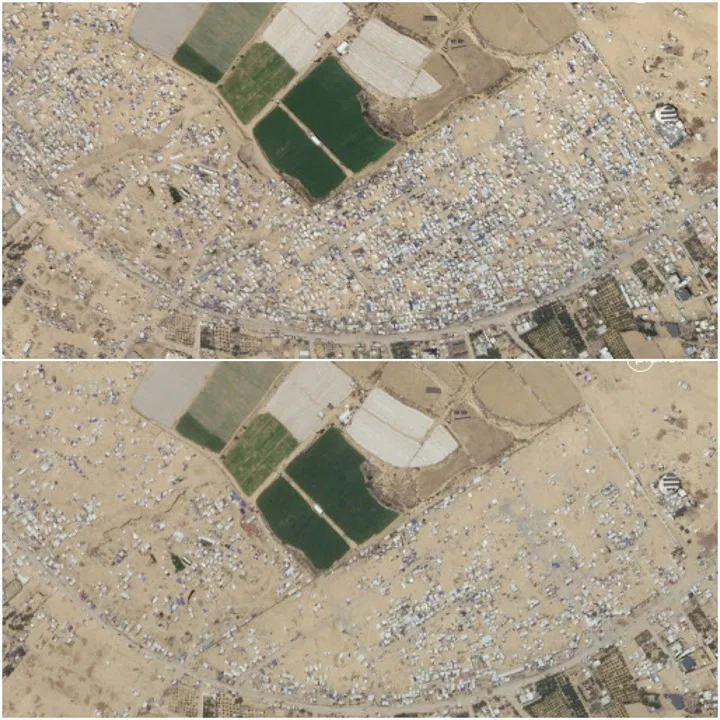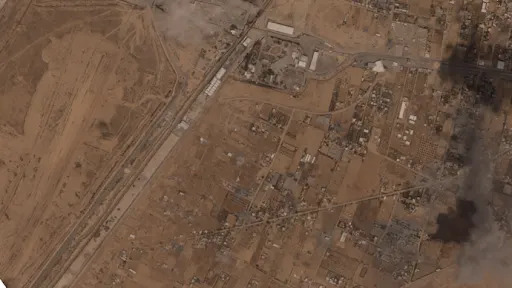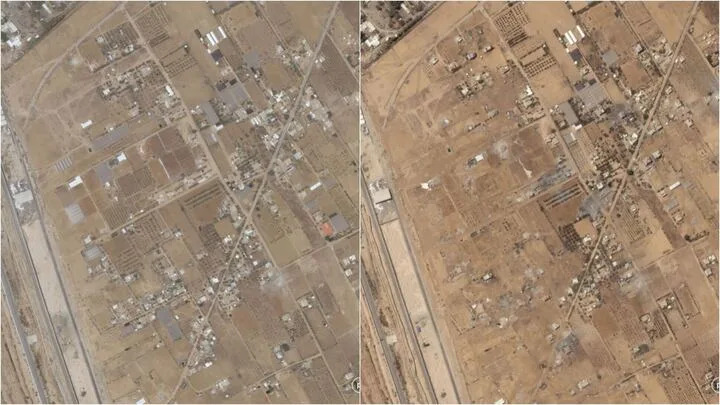Satellite images of Rafah illustrate Palestinians fleeing the city

Satellite images taken earlier this month offer a spaceborne perspective of the ongoing Israel-Hamas war. They include scenes such as a before-and-after sequence that illustrates Palestinian civilians fleeing Rafah, a view of damaged buildings in the region and conglomerates of Israeli hardware.
For the past several months, Israeli Defense Forces (IDF) have destroyed major portions of areas in which Palestinian civilians live as a response to the Oct. 7 terrorist attack in Israel, an attack orchestrated by the radical militant group Hamas. As Reuters reported on May 14, Israel says Hamas killed more than 1,200 people, mostly civilians, and took 253 people to captivity in Gaza; the Palestinian Health Authorities say the IDF's military campaign since then has killed more than 35,000 people, also mostly civilians, and has driven 2.3 million people from their homes.
More than 1 million Palestinian refugees have been sheltering in the city of Rafah, most of whom were displaced after the bulk of northern Gaza was decimated due to Israeli air- and ground-based strikes. The IDF recently began requesting that the refugees evacuate from Rafah as well, suggesting impending military action in the area despite warnings from allies including the U.S. that a major military operation there would be devastating for the Palestinian civilian population. Some of the recent satellite images were captured after Israeli Defense Forces seized control of Gaza's Rafah border crossing ahead of the possible ground-based invasion.
Get AfriPrime Android Web View app....Click the link to Amazon app store to download https://rb.gy/3xek46
More specifically, Palestinians were told to move to an "expanded humanitarian area" in al-Mawasi and Khan Younis, according to NPR, which are north and northwest of the city. Satellite imagery obtained by Planet Labs shows the extent of the tents in Rafah on May 5 and May 8.

A CNN analysis of the satellite images identified "several camps sheltering Gaza's vast refugee population — including the main camp in central Rafah that housed thousands of tents," and found that the camps have significantly decreased in size between May 7 and May 8. It was on May 6 when evacuation orders were sent to those sheltering in Rafah, through phone messages and leaflets dropped from overhead. From a non-space-based perspective, NPR reporters said they saw people "frantically packing their belongings and fleeing the area on foot."
The New York Times analyzed the satellite images as well, highlighting aspects such as damaged buildings "reaching more than two miles into the territory near Rafah's border crossing with Egypt," as well as rising smoke nearby and stationed Israeli tanks. "While it is not possible to know exactly what caused the damage shown in the satellite imagery, much of what can be seen is consistent with the aftermath of clearing operations and other Israeli ground operations elsewhere in the Gaza Strip," the New York Times reports.


As of May 14, The United Nations agency for Palestinian refugees said that about 360,000 Palestinians have been able to leave Rafah over the past week, out of the approximately 1.3 million who had been sheltering there. Many countries have called for a ceasefire to the war, including those who say Israel's actions constitute a genocide; individuals across the world have spoken in favor of both sentiments as well, including students and academic experts. This past Sunday, U.N. Secretary-General Antonio Guterres urged for "an immediate humanitarian cease-fire, the unconditional release of all hostages, and an immediate surge in humanitarian aid."
"A ceasefire will only be the start," he said. "It will be a long road back from the devastation and trauma of this war."
Get AfriPrime Android Web View app....Click the link to Amazon app store to download https://rb.gy/3xek46
Israel targets Hamas training ground on outskirts of Rafah, ramps up attacks in northern Gaza
Israeli forces ramped up operations in both northern Gaza and the eastern outskirts of Rafah, targeting terrorist infrastructure and a Hamas training camp.
The IDF operations involved airstrikes on roughly 80 terrorist targets, "including military compounds, weapons storage facilities, missile launchers, observation posts, and additional terrorist infrastructure," Israel said.
The operations in eastern Rafah saw Israeli soldiers engage in close-quarters combat with Hamas terrorists at one of the group's training grounds. IDF soldiers there recovered a trove of Israeli military equipment and vehicles, which Hamas had used to simulate fighting against Israeli forces.
Images from the training ground show that Hamas had even acquired an Israeli Merkava main battle tank.
Get AfriPrime Android Web View app....Click the link to Amazon app store to download https://rb.gy/3xek46

The IDF operations in northern Gaza targeted terrorist cells in the Jabaliya refugee camp, including airstrikes on one cell that had fired rockets onto the Israeli city of Sderot on Tuesday.
The operations come as Israel tests the limits of President Biden's demand that Israeli forces not conduct an invasion of Rafah. Biden vowed last week that the U.S. would withhold weapons shipments to Israel if it moved forward with a full-scale operation in the city.

Rafah plays host to roughly 1.5 million displaced Palestinians, most of whom fled northern Gaza. Israel, however, says the city is also the final major stronghold for Hamas in the region.
Get AfriPrime Android Web View app....Click the link to Amazon app store to download https://rb.gy/3xek46
Israeli Prime Minister Benjamin Netanyahu has repeatedly stated that an invasion of Rafah will take place at some point. He has yet to publicly address Biden's red line on the issue.

Biden's administration offered to share intelligence on Hamas leadership with Israel in exchange for restraint in Rafah earlier this week, according to a Washington Post report.
The intelligence the U.S. offered reportedly would allow Israel to better pinpoint Hamas leaders hidden in tunnels around the city, making it possible for the Israeli military to engage in a more precise campaign that could avoid the devastation seen in other areas of Gaza throughout the conflict.
- Questions and Answers
- Opinion
- Story/Motivational/Inspiring
- Technology
- Art
- Causes
- Crafts
- Dance
- Drinks
- Film/Movie
- Fitness
- Food
- Games
- Gardening
- Health
- Home
- Literature
- Music
- Networking
- Other
- Party
- Religion
- Shopping
- Sports
- Theater
- Wellness
- News
- Culture
- War machines and policy

